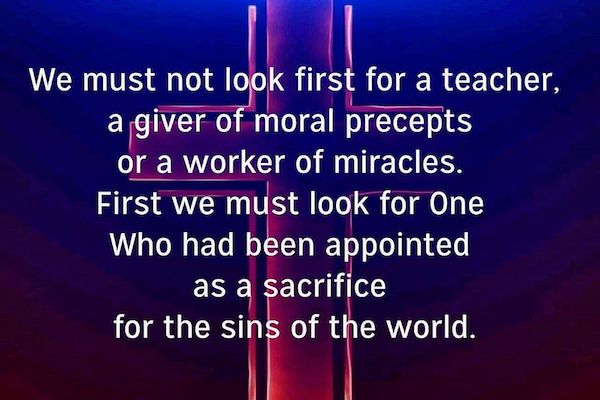LENT 2024: Day 7 - LIFE OF CHRIST

LENT 2024: DAY 7 - Wednesday February 21
“Now that Our Lord had mastered the supreme temptation to become the King of men by filling their stomachs, by thrilling them with scientific wonders, and by making a political deal with the prince of darkness, he was ready to go before the world as a sacrificial victim for sin.
“Look this is the Lamb of God; look, this is He Who takes away the sin of the world.” (John 1:29) John [the Baptist] was affirming that we must not look first for a teacher, a giver of moral precepts or a worker of miracles. First we must look for One Who had been appointed as a sacrifice for the sins of the world. The Passover was approaching, and the highways were filled with people driving or carrying their one-year-old lambs to the temple to be sacrificed. In full view of those lambs, John pointed out the Lamb Who, when sacrificed, would end all sacrifices in the temple, because he would take away the sins of the world.
John was the parting voice of the Old Testament, in which the lamb played such an important role. In Genesis, we find Abel offering a lamb, the firstling of his flock, in a bloody sacrifice for the expiation of sin. Later on, God asked Abraham to sacrifice his son Isaac – a prophetic symbol of the Heavenly Father sacrificing His own Son. When Isaac asked, “Where is the lamb?” Abraham said: “My son, God will see to it that there is a lamb to be sacrificed.” (Genesis 22:8)
The answer to the question, “Where is the lamb of sacrifice?” asked in the beginning of Genesis, was now given by John the Baptist as he pointed to Christ and said, “Here is the Lamb of God.” God had at last provided a Lamb.
Every family sought to have its own Paschal Lamb; and those who were now taking their lambs to Jerusalem, where the Lamb of God said that He must be sacrificed, knew that the lamb was a symbol of Israel’s deliverance from the political slavery of Egypt. John was saying that it was also a symbol of deliverance from the spiritual slavery of sin.
The lamb was most often used as a victim of sacrifice, because of its innocence and mildness; therefore, it was an emblem most suited to the character of the Messias. The fact that John the Baptist called Him the Lamb of God is most significant; He was neither the peoples’ lamb, nor the lamb of the Jews, nor the lamb of any human owner, but the Lamb of God. When the Lamb was finally sacrificed, it was not because He was a victim of those who were stronger than Himself, but rather because He was fulfilling His willing duty of love for sinners. It was not man who offered this sacrifice, although it was man who slew the victim; it was God Who gave Himself.
“What was the ransom that freed you… you know well enough that it was not paid in earthly currency, silver or gold; it was paid in the Precious Blood of Christ; no Lamb was ever so pure, so spotless a Victim.” (1 Peter 1:18-19)
St. John the Evangelist… stood at the foot of the Cross when the Lamb was sacrificed. Years later, he wrote that the Lamb slain on Calvary was by intent slain from the beginning of the world. The Cross was not an afterthought. “The Lamb slain in sacrifice ever since the world was made.” (Apocalypse 13:8) This means that the Lamb was slain, as it were, by Divine decree from all eternity, though the temporal fulfillment had to await Calvary. His death was according to God’s eternal plan and God’s determinate counsel. But the principle of self-sacrificing love was eternal. Redemption was in the mind of God before the foundation of the world was laid. God, Who is outside time, saw from all eternity mankind falling, and being redeemed.

(Chapter 4, pgs. 132-137)
+ FRASES PARA LEER